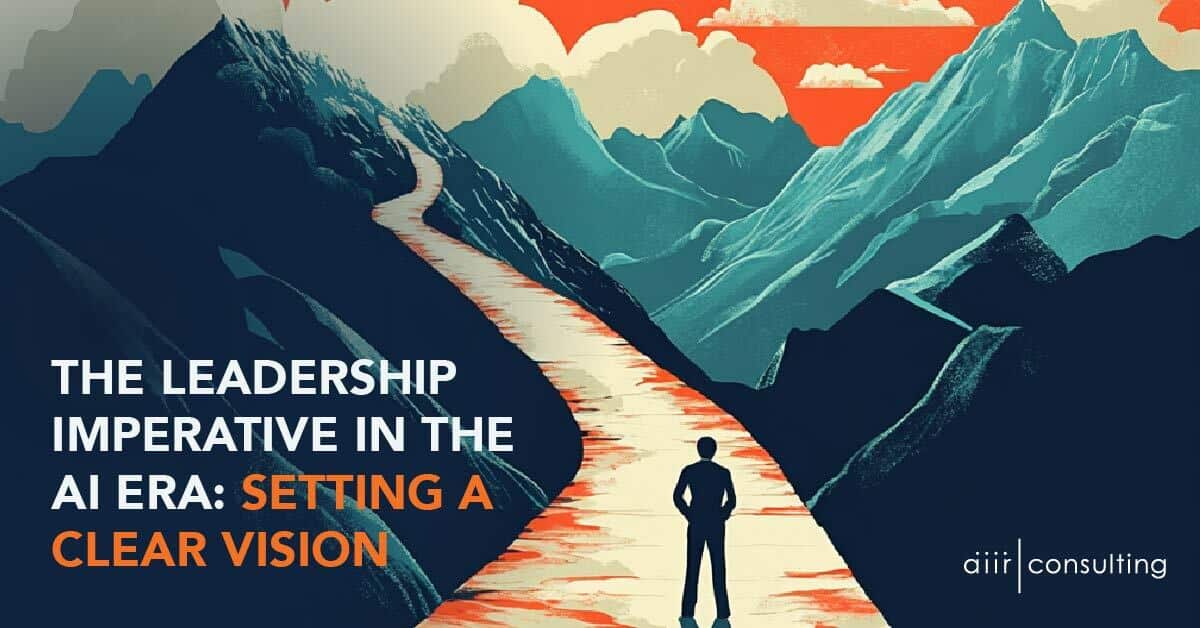
The Leadership Imperative in the AI Era: Setting a Clear Vision
By Jonathan Kirschner | March 26, 2025
In today’s rapidly evolving business landscape, artificial intelligence is no longer just a technological novelty — it’s a transformative force reshaping how we work, communicate, and lead. As organizations worldwide grapple with this unprecedented shift, a critical question emerges: Will leaders proactively shape AI’s impact on their organizations, or will they simply react to changes as they unfold?
In my years as both a CEO and leadership advisor, I’ve observed a stark truth: The difference between organizations that thrive in change and those that struggle isn’t tied to technology investments, big promises, or transformation projects — it’s about leadership capabilities. Organizations need leaders who can navigate a new terrain with the right skills that meet the demands of their strategic context.
The Three-Dimensional AIIR Leadership Framework
At AIIR, we define leadership as the ability to actualize a clear and compelling vision through others. Leadership is a timeless concept and possibly one of the most consequential factors that leads to the success or demise of a system, company, civilization, or government. At its core, leadership requires skills in three broad areas:
Leading Self
Mastery of one’s own time and energy, the ability to problem-solve and make decisions, and the capacity to regulate emotion.
Leading Others
Collaboration, team leadership, coaching skills, and building connections.
Leading the Organization
Visioning, strategic thinking, navigating change, and building culture.
Great leaders have a grip on all three domains broadly, but they excel at certain skills that are crucially important based on the context. If an organization needs a turnaround, the leader needs to be incredibly strategic, decisive, and exceptional at prioritizing. If a leader is managing rapid growth, they will need strong execution, constant communication, and excellent teaming skills. An organization seeking to maintain growth requires relationship management, culture-building skills, and the ability to systematically manage people’s performance.
The AI Revolution and Leadership
The AI revolution underway has created incredible opportunities, massive uncertainty, and unprecedented change. Jobs once done by humans are carried out by AI agents, and soon robots, at a fraction of the time and cost. The ability to produce a graphic, an article, a data analysis, or even a coding project is reduced from weeks and months to minutes. What may have made a leader successful pre-AI is likely to fail in this new strategic context.
At AIIR, we asked ourselves: what leadership skills would be the most important to develop and harness in the context of the AI revolution? In a context where leading “others” is not only humans but also AI systems?
Using our proprietary Leadership Genome methodology, we identified seven critical leadership skills out of the 45 leadership skills in the AIIR® Leadership Framework that matter the most in the AI era:
- Setting Vision
- Resilience
- Curiosity
- Communication
- Strategic Thinking
- Problem-Solving
- Decision Quality
In this article, we’ll focus on the most foundational skill — Setting Vision — while future articles will explore the remaining six skills.
Setting Vision: The Foundation of AI Leadership

Setting a Vision is the most important starting point for leaders seeking to harness AI for organizational success. Setting a vision means establishing and communicating a clear and compelling future state, usually connected to organizational advances, and reinforcing it over time. Importantly, a vision is not a strategy. A vision is a destination. It describes where we are going and why. Great visions are clear and compelling, and because of this, the vision becomes an anchor for meaning-making.
A clear and compelling vision does not just spring up spontaneously or emerge in response to a threat. Vision setting starts with having the space to reflect and think. For busy leaders, finding that mental space is half the battle. But assuming that battle is won, leaders should take their time and use both people and AI as sounding boards. What do you think about this vision? If you had to critique it, what would you say? Does this vision motivate you? Does it move you? Is it sufficiently clear?
Vision in Action: A Tale of Two Leaders
Let’s examine two vision examples:
Bob, the CEO of a manufacturing company, faces heating competition as his two main competitors have made massive investments in robotics and AI supply chain management. His vision:
“We need to all use AI yesterday. We won’t survive the increasingly complex competitive landscape if we are not first movers in AI. We’ve gotta seize on this opportunity to drive productivity, impact, and customer satisfaction.”
While this vision expresses urgency, it is overly vague and non-specific about how using AI will actually create business value. Sarah, the COO of a cybersecurity firm that is 2-3 years away from going public, offers this vision:
“We need to use AI tools to drive increased productivity in our operations and product innovation for our customers. Everyone will receive an initial LLM package and training and we’ve also hired an AI consultancy to build a customized agent for our tier 1 customer support inquiries. These are just two of many more investments we’ll be making in AI. If we get this right, we’ll be in a position to leapfrog our competition and accelerate our path to IPO.”
Unlike Bob’s vision, Sarah is specific about where the organization is going and why. Employees in Sarah’s firm will have the clarity and intrinsic motivation to move forward with AI adoption. Bob’s employees will experience more variability in their motivation and understanding of the mission. This will in turn affect their ability to strategize and execute.
Reinforcing the Vision
Even the best visions eventually blur if they are not consistently reinforced. While Bob shared his vision in an all-company town hall and in numerous one-on-one meetings, getting AI adoption has been an uphill slog with only 25% of the organization using AI on a weekly basis.
On the other hand, Sarah, who also launched her vision in a town hall:
- Sends monthly company-wide emails
- Has instructed her direct reports to start their team meetings with a check-in on AI adoption
- Has disseminated a laminated one-page graphic outlining the vision and her top 5 annual business goals
As a result, over 70% of Sarah’s organization is using AI on a daily basis.
Building the Vision Muscle
Like all skills, setting vision is a muscle that requires practice and repetition. As that muscle grows, so too does the rapid innovation of AI tools and functionality. Leaders with a clear vision create organizational alignment that enables faster adoption, more cohesive implementation, and ultimately, greater competitive advantage.
- When crafting your AI vision, consider these questions:
- How specifically will AI enhance your organization’s core mission?
- What tangible outcomes will indicate successful AI integration?
- How will your organization’s customers benefit from your AI adoption?
- What will your employees’ relationship with AI look like in the ideal state?
- How does your vision differentiate your organization’s AI approach from competitors?
Looking Ahead
To keep pace with the rapid evolution of AI, leaders need more than just a clear vision. They need the right combination of resilience to weather implementation challenges, curiosity to continuously explore AI’s evolving capabilities, and strategic thinking to connect AI initiatives to business outcomes.
In our next article, we’ll explore how these three critical skills — resilience, curiosity, and strategic thinking — help leaders translate their vision into sustainable AI adoption. Following that, we’ll examine problem-solving, communication, and decision quality as essential capabilities for AI-era leaders.
Like Sarah demonstrated, the journey begins with a clear, compelling vision that answers the fundamental question: AI for what purpose? With that clarity established, organizations can move forward with confidence, direction, and shared purpose in the AI revolution.
Jonathan Kirschner, Psy.D. is a business psychologist, CEO of AIIR Consulting, and a subject matter expert on the intersection of leadership and AI.